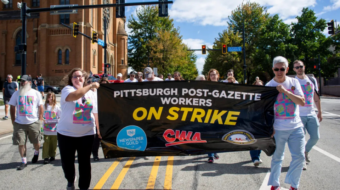Once the CNN trucks roll out, the national story dies on the vine, but for mining families and the United Mine Workers union in West Virginia, the recent coal mine disasters just won’t go away.
After Jan. 2, when 12 miners died at the Sago Mine, words and photo-ops simply don’t cut it. Words don’t add up to safe workplaces. Photo-ops don’t guarantee that mine corporations, swimming in profits, will obey the law.
In the first four weeks of this year, 18 coal miners died at work in West Virginia and Kentucky. West Virginia was hardest hit. With 16 hard-working families in mourning because their husbands, fathers or sons did not come home from work, the Mountain State is in the eye of a grief and anger hurricane.
The Sago explosion was the worst in West Virginia in 40 years.
The Sago mine is nonunion.
House Democrats held a hearing in Washington Feb. 13 for the surviving families. The Republican House leadership rejected participation in such hearings until the Mine Safety and Health Administration (MSHA) issues its report. It takes over a year for a MSHA report to come out.
“It breaks my heart to know that there is modern technology that could have saved my husband’s life and the Sago Mine wasn’t equipped with it,” Deborah Hamner, widow of Sago explosion victim George Junior Hamner, told Democratic members of the House.
Hamner’s daughter Sara Bailey read a note her father left in his lunch bucket that adds to the evidence that the trapped miners survived at least 10 hours awaiting rescue.
“Why hasn’t MSHA required mines to be equipped with rescue chambers or at least extra air supplies,” Deborah Hamner asked the elected officials. “Why does Canada have better protections for their miners than we have in the United States?”
Hamner pointed to the rescue of 72 underground potash miners within two weeks of the Sago disaster because the potash mine had “safe chambers” packed with oxygen and supplies.
“It’s ridiculous that I can get a computer and make a web site in an hour but no one could find my dad,” Amber Helms testified. Her father, Terry Helms died inside the Sago Mine, owned by the International Coal Group (ICG). “The technology is out there. In Australia they have tracking devices that cost as little as $20. What’s $20 to a company?”
The 140 miners at the Sago Mine produced $16 million in revenue for ICG through the third quarter of 2005.
Families told members of Congress that ICG has barred both the UMWA and their attorneys from interviews, part of the investigation to identify the cause of the explosion.
In a Feb. 7 letter to MSHA, United Mine Workers President Cecil Roberts demanded that the agency enforce its own laws allowing union representatives to accompany miners and their family members to interviews, whether they are union members or not.
“The miners we represent at Sago have been deprived of their right to have us (UMWA) participate in the interviews,” Roberts said. “We remain eager to fulfill our statutory role as their representative and only ask that we be allowed to do so.”
A Feb. 14 article in The Coal Valley News, a newspaper serving Boone County, W.Va., site of the Feb. 1 death of Paul Moss, charged that Massey Energy barred emergency personnel from their property during the recent catastrophe there.
Massey Energy’s Black Castle mine is a strip mining operation. Moss, 58, was operating a bulldozer when he hit a gas transmission line, causing a terrific blast.
When Boone County emergency medical services (EMS) personnel arrived at the scene, Massey guards barred them at the gate. Only when Sterling Lewis, the state fire marshal, arrived and threatened Massey guards with jail did they lower the gate, allowing EMS technicians on the property. In a sharp message to coal companies around the state, Lewis told WSAZ-TV, “You need to rethink this real quick and if you don’t rethink this, we have the authority to put you in jail.”
It took EMS an hour, but they found Moss’ body 200 feet into the tree line.
Massey’s Black Castle mine is also nonunion.









